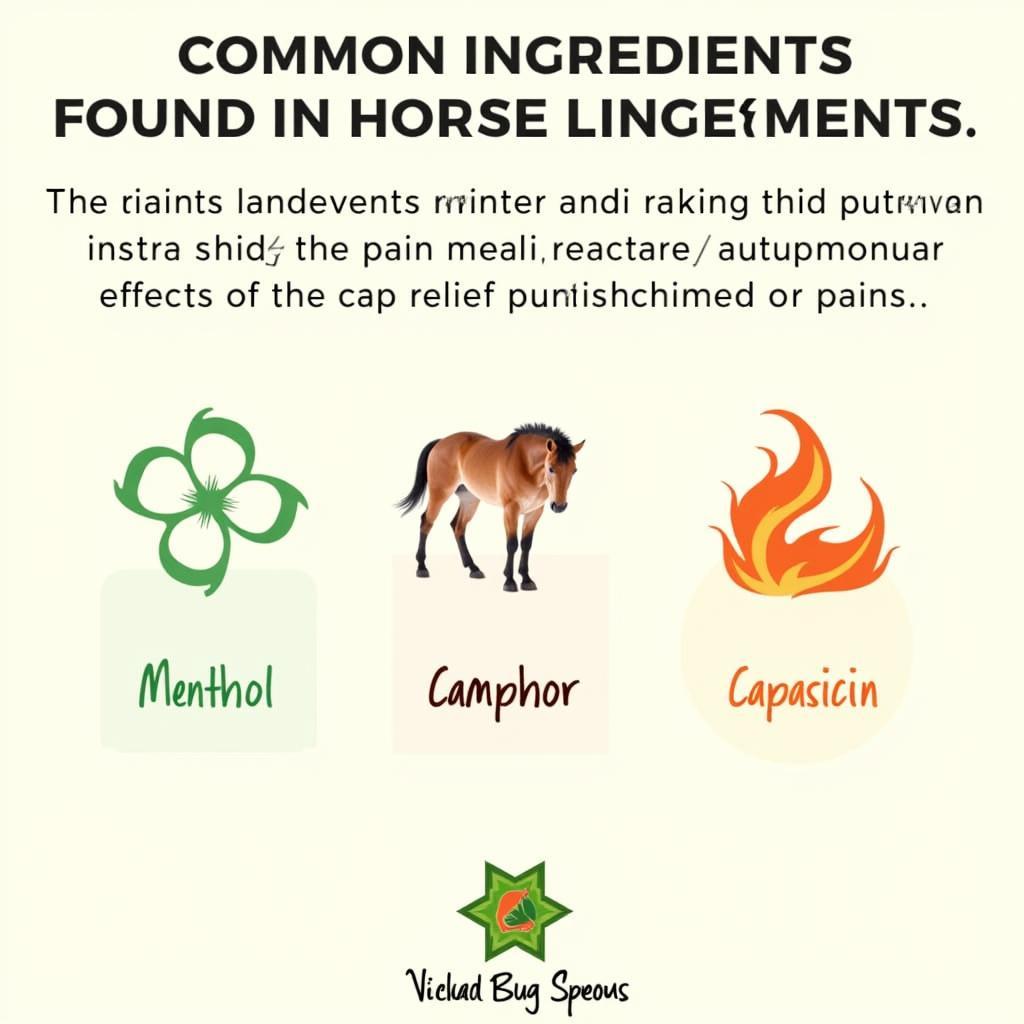Horse Liniment For Pain relief is a common tool in many equine first-aid kits. But with so many options available, understanding how to choose and use these topical treatments effectively is crucial for responsible horse ownership. This guide delves into the world of horse liniments, exploring their benefits, risks, and best practices for application.
Understanding Horse Liniment
Horse liniment is a topical medication applied to the skin to relieve muscle soreness, stiffness, and inflammation. These solutions typically contain ingredients like menthol, camphor, or capsaicin, which create a warming or cooling sensation, increasing blood flow to the affected area. This increased circulation can help reduce pain and promote healing. Different liniments offer varying levels of strength and are formulated for specific purposes, such as reducing swelling or easing muscle spasms. Over the counter pain relief for horses is an important subject for horse owners.
Types of Horse Liniment
There are several types of horse liniment available, including:
- Cooling liniments: These often contain menthol or alcohol and provide a cooling sensation that can help numb the area and reduce inflammation. They are commonly used for acute injuries like sprains and strains.
- Warming liniments: Formulated with ingredients like capsaicin or wintergreen oil, these create a warming sensation that increases blood flow and relaxes muscles. They are beneficial for chronic conditions like arthritis or muscle stiffness.
- Combination liniments: These combine both cooling and warming agents to offer a broader range of pain relief.
Choosing the right type of horse liniment for pain depends on the specific condition being treated. Always consult with a veterinarian to ensure the product is appropriate for your horse’s needs.
Applying Horse Liniment Safely and Effectively
Proper application of horse liniment for pain is crucial to avoid irritation or other adverse reactions. Before applying, always clean the affected area thoroughly. Apply the liniment according to the manufacturer’s instructions, typically using a gentle, circular motion. Avoid applying liniment to broken skin or open wounds.  Common Horse Liniment Ingredients and Their Effects
Common Horse Liniment Ingredients and Their Effects
Precautions and Potential Side Effects
While generally safe, horse liniment can cause skin irritation in some horses. Always test a small area first and monitor for any adverse reactions. Never use liniment on horses with known allergies to any of the ingredients. If your horse experiences excessive redness, swelling, or discomfort, discontinue use and consult your veterinarian. Sore no-more horse provides further information on managing equine discomfort.
Choosing the Right Horse Liniment
Selecting the appropriate horse liniment for pain involves considering the type of injury or condition, the horse’s individual sensitivity, and the specific ingredients in the product. Some liniments are formulated for use under bandages, while others should not be covered. Horse leg wraps for riding offers valuable insights into proper bandaging techniques.
When to Consult a Veterinarian
While horse liniment can be an effective tool for managing minor aches and pains, it’s important to consult a veterinarian for any serious injuries or persistent lameness. Liniment should not be used as a substitute for proper veterinary care.
“A proper diagnosis is essential before using any pain relief treatment,” advises Dr. Emily Carter, DVM, specializing in equine sports medicine. “Horse liniment can be helpful for managing minor discomfort, but underlying conditions require professional attention.”
Conclusion
Horse liniment for pain can be a valuable addition to your horse’s first aid kit. By understanding the different types of liniment available, applying them correctly, and consulting with your veterinarian when necessary, you can effectively manage your horse’s discomfort and help them stay comfortable and perform at their best. Always choose a high-quality product and prioritize your horse’s well-being. Best liniment for horses can guide you through selecting the optimal product. Remember, proper pain management is crucial for maintaining your horse’s overall health and performance.
FAQ
- Can I use human liniment on my horse?
- How often should I apply horse liniment?
- What should I do if my horse licks the liniment?
- Can I use liniment on a pregnant mare?
- Are there any natural alternatives to horse liniment?
- Can I use liniment before or after riding?
- How should I store horse liniment?
Liquid bandage for horses might be an alternative solution for some injuries.
For further support, contact us at Phone: 0772127271, Email: [email protected], or visit us at QGM2+WX2, Vị Trung, Vị Thuỷ, Hậu Giang, Vietnam. We have a 24/7 customer support team.